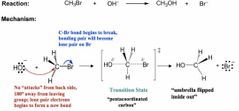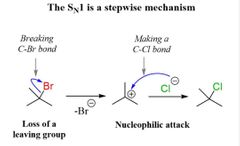![]()
![]()
![]()
Use LEFT and RIGHT arrow keys to navigate between flashcards;
Use UP and DOWN arrow keys to flip the card;
H to show hint;
A reads text to speech;
29 Cards in this Set
- Front
- Back
|
How do you determine the amount of recrystallization solvent to use? |
Use data on the solubility of the compound in the solvent to calculated the minimum amount of hot solvent to use. The minimum amount should always be used to promote crystallization. |
|
|
What are the properties of a "perfect" recrystallization solvent? |
Soluble in hot solvent, insoluble in cold solvent. |
|
|
What is meant by "reflux" and what purpose does it serve? |
Refluxing is the process of heating a solution to boiling while simultaneously cooling the vapors back to liquid. This A) speeds up the reaction by applying heat and B) prevents any loss of solvent to evaporation. |
|
|
Briefly explain the difference between precipitation and crystallization. |
Precipitation results in solid particles that are denser than the rest of the solution. These particles can be crystalline solids or amorphous solids. Crystallization is the same process as precipitation, except the precipitate is crystalline and easily separable, never amorphous. |
|
|
Show an SN2 mechanism |

|
|
|
Show an SN1 Mechanism |

|
|
|
Briefly explain how to do TLC chromatography. |
1. Spot solute onto plate. 2. Place in chamber with solvent. 3. Mobile phase rises until a centimeter from top of plate. 4. Development spots with a UV light or iodine gas. 5. Measure and calculate Rf values. |
|
|
Explain the difference between TLC and Column chromatography. |
TLC: mobile phase flows across a flat surface stationary phase Column: mobile phase flows through a column full of powdered stationary phase (alumina, silica) |
|
|
Why are Teflon cards incompatible with protic solvents i.e. water, alcohols? |
Teflon cards are nonpolar and only work with nonpolar solvents. Protic solvents are polar. |
|
|
Why does acetone perform well as an IR solvent? |
It is good at dissolving both polar and nonpolar substances. |
|
|
What is the "most" important safety equipment? |
Goggles |
|
|
Why should you not pipette from a reagent bottle? |
This can contaminate the pure compound in the reagent bottle and affect everyone's results. |
|
|
Waste in the CHEM 2423 lab is divided into two categories, what are they? |
Halogenated and non-halogenated waste. |
|
|
Melting points are often referred to as an "Index of Purity". Explain what that means. |
Pure compounds will have a higher melting point, but some compounds are impure and have a range of lower melting points. The purer the substance, the higher the melting point within the range. |
|
|
Why is it best to not use too much drying agent? |
Drying agent is used to remove excess water, too much drying agent will remove water that is necessary. |
|
|
Name two ways to visualize TLC spots. |
UV lamp & Iodine gas |
|
|
When doing TLC why should the solvent never be allowed to run to the top of the plate? |
The Rf values cannot be calculated and some of the spots may run off the plate altogether. |
|
|
Why can you NEVER add activated charcoal to a hot liquid? |
The activated charcoal particles will act like thousands of boiling chips causing the solution to boil over and foam. |
|
|
What role did the ammonium formate play in the Hydrogenation experiment? |
Used for "in situ" hydrogen creation |
|
|
Why is it important to always place a tube (sample or water) opposite to your sample in the centrifuge? |
To balance out the centrifuge. An unevenly balanced rotor can break the centrifuge. |
|
|
What reagent was used in the SN1& SN2 experiment to facilitate an SN1 reaction? |
Silver Nitrate (AgNO3) in Ethanol |
|
|
What reagent was used in the SN1& SN2 experiment to facilitate an SN2 reaction? |
Sodium Iodide (NaI) in Acetone |
|
|
Explain the difference between % recovery and % yield. |
% Recovery: ratio between the initial amount and ending amount % Yield: ratio between the actual yield and theoretical yield |
|
|
Why is % recovery used with natural products and not % yield? |
Natural products are impure, so % recovery is used to see how much compound was pure and how much was impurities. |
|
|
Explain how to calculate Rf values from a TLC plate. |
Rf = distance to sample / distance to solvent front |
|
|
How does the KMnO4 test confirm the presence of a carbon-carbon bond? |
It changes color from purple to brown in the presence of an alkene. Changed alkenes to diols. |
|
|
Calculate the % recovery of caffeine from tea (or coffee) if a 5.6 g sample yielded .196 g caffeine. |
.196 / 5.6 = .035 .035 × 100 = 3.5% |
|
|
Why are melting points always given as a range? |
Solids dont melt all at once. The lowest MP value is when they begin to melt and the highest MP value is when they're fully melted. |
|
|
What is the purpose of dropping the melting point capillary tube with sample through the larger diameter glass tube, when preparing a MP sample? |
The sample will be more tightly packed - if air is trapped within the sample, this will not allow for uniform heating and MP cannot be determined accurately. |

